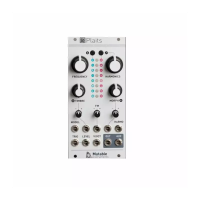appropriate compensation to keep the pitch unchanged).
MORPH: phoneme or word segment selection. When HARMONICS is past 11 o’clock, a list of words can
be scanned through by turning the MORPH knob or by sending a CV to the corresponding input. One can
also patch the trigger input [3] to trigger the utterance of a word, use the FM attenuverter to control the
intonation and the MORPH attenuverter to control speed.
AUX: unfiltered vocal cords’ signal.
A swarm of 8 enveloped sawtooth waves.
HARMONICS: amount of pitch randomization.
TIMBRE: grain density.
MORPH: grain duration and overlap. When this setting is fully CW, the grains merge into each other: the
result is a stack of eight randomly frequency-modulated waveforms.
AUX: variant with sine wave oscillators.
To get a nice “supersaw” waveform, try a moderate amount of pitch randomization and grain density, with
full grain overlap.
Variable-clock white noise processed by a resonant filter. The cutoff frequency of the filter is controlled by
the FREQUENCY knob and the V/OCT CV input. This allows proper tracking!
HARMONICS: filter response, from LP to BP to HP.
TIMBRE: clock frequency.
MORPH: filter resonance.
AUX: variant employing two band-pass filters, with their separation controlled by HARMONICS.
Mutable Instruments | Plaits
7 of 11

